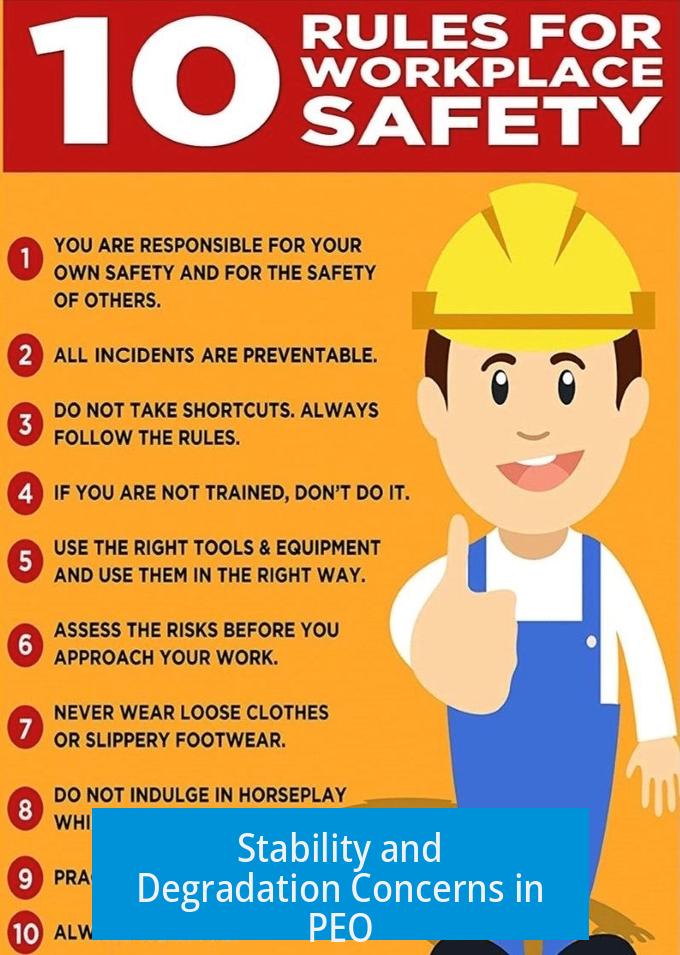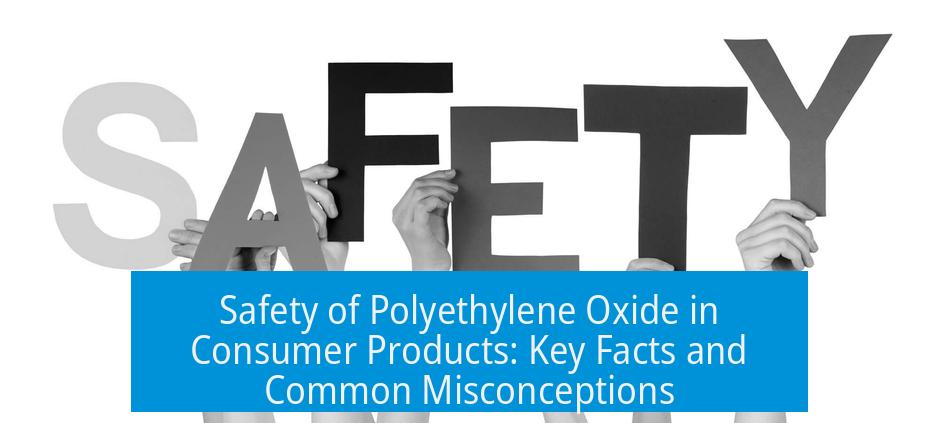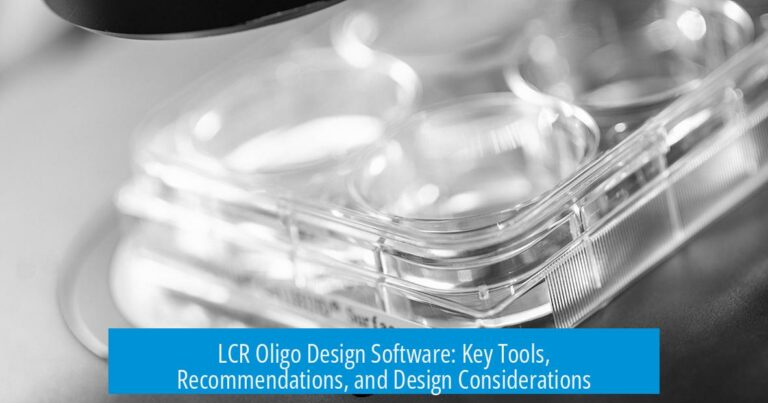Safety of Polyethylene Oxide in Consumer Products

Polyethylene oxide (PEO) is safe for use in consumer products due to its distinct chemical properties, regulatory oversight, and controlled manufacturing processes that prevent residual toxic impurities. This safety is grounded in PEO’s stable polymeric structure, which differs significantly from its reactive precursor, ethylene oxide. Many consumer products, including cosmetics and medical formulations, rely on PEO, reflecting its established safety profile.
Chemical Nature and Differences from Ethylene Oxide
PEO originates from ethylene oxide but possesses fundamentally different chemical traits. While ethylene oxide is an epoxide featuring a strained three-membered ring, PEO is a polymer comprised of repeating ether linkages terminated by alcohol (-OH) groups. Ethylene oxide’s epoxide ring confers high reactivity and alkylating potential, which can damage biomolecules and cause toxicity. In contrast, PEO’s polymeric di-alcohol structure exhibits substantial chemical stability.
- Ethylene oxide: reactive, toxic, epoxide ring
- Polyethylene oxide: stable polymer, polyether chain, terminal hydroxyl groups
This chemical distinction means PEO does not exhibit the acute toxicity and carcinogenic risks associated with ethylene oxide. PEO is chemically inert in most consumer contexts, reducing concerns related to its monomer precursor.
Stability and Degradation Concerns in PEO

Over time, PEO can slowly form peroxides under atmospheric oxygen, especially when exposed to heat and light. These peroxides may initiate chain scission, breaking PEO into shorter fragments and releasing degradation products. However, these products do not include ethylene oxide, nor do they possess the same reactive hazards.
Manufacturers commonly add radical inhibitors or stabilizers to PEO formulations to minimize peroxide formation. Proper storage—cool, dark environments—and avoiding aged products further limit degradation risks.
| Factor | Impact on PEO | Mitigation |
|---|---|---|
| Exposure to air (oxygen) | Slow peroxide formation | Use of radical inhibitors |
| Heat | Accelerates degradation | Cool storage conditions |
| Light | Promotes chain scission | Store in dark containers |
These passivation steps limit the buildup of undesirable or unsafe degradation products, ensuring product integrity throughout shelf life.
Residual Ethylene Oxide: Processing and Regulation
One safety concern involves residual ethylene oxide that may remain unreacted in PEO products. Ethylene oxide is volatile, with a low boiling point (~10.7°C), facilitating its removal during purification stages. Strict regulatory limits govern allowable residual monomer levels to prevent toxic exposure.
Regulatory authorities, including the U.S. Food and Drug Administration (FDA) and European Medicines Agency (EMA), enforce stringent quality standards ensuring residual ethylene oxide is minimal, typically measured in parts per million or lower.
Quality control (QC) laboratories conduct purity testing using techniques like gas chromatography to verify compliance. These measures eliminate risks from residual ethylene oxide, ensuring consumer safety.
Demonstrated Safety in Consumer and Medical Applications
PEO’s safety profile is well established. It is widely employed in cosmetics, skin care products, and medical uses, including as a laxative and vehicle in drug formulations. For example, in bowel preparation for colonoscopy, patients ingest large doses (60-70 g) of polyethylene glycol, a closely related compound, without adverse effects.
Key factors supporting safe human use:
- Extensive industrial testing confirming purity and identity
- Low chemical reactivity reducing biological interaction risks
- Regulatory oversight verifying manufacturing quality
- Long history of safe topical and oral application
Since PEO can be safely ingested in relatively large amounts and applied to the skin, its use in diverse consumer products is justified by rigorous safety data.
Addressing Common Misconceptions
Consumers often confuse polyethylene oxide with ethylene oxide due to their similar names. This misunderstanding fuels unfounded toxicological concerns.
- PEO is a polymer, ethylene oxide is the reactive monomer
- PEO lacks the epoxide group responsible for ethylene oxide’s harmful effects
- Being made from a hazardous chemical does not imply a final product is dangerous (e.g., salt from chlorine gas)
Natural ingredients can contain impurities such as pesticides and heavy metals, whereas synthetic PEO is manufactured under controlled conditions for purity and safety.
It is important to consider dose in toxicity; all substances can be harmful at sufficiently high doses. PEO’s safe usage doses are well within non-toxic ranges.
Summary of Key Points
- Chemical stability: PEO is a stable polymer without the reactive epoxide ring of ethylene oxide.
- Degradation management: Radical inhibitors and proper storage prevent peroxide formation and degradation products.
- Residual monomer control: Regulatory standards ensure ethylene oxide residues remain minimal and safe.
- Proven safety record: PEO is widely used in cosmetics and medical products, demonstrating safety for topical and oral use.
- Misconception clarification: Polymerization fundamentally alters chemical properties, invalidating concerns based solely on precursor toxicity.
What makes polyethylene oxide (PEO) different from ethylene oxide in terms of safety?
PEO is a stable polymer with di-alcohol ends, unlike ethylene oxide which is highly reactive and toxic due to its epoxide ring. PEO does not have the same chemical reactivity or toxicity concerns.
Can polyethylene oxide degrade into harmful substances over time?
PEO can slowly form peroxides when exposed to air, light, and heat, which may break down the polymer chain and create impurities. However, these are not ethylene oxide and are generally controlled by adding stabilizers and proper storage.
Is there a risk of residual ethylene oxide in products containing PEO?
Residual ethylene oxide is a concern only if present in significant amounts. Strict regulations limit its levels, and it is easy to remove due to its low boiling point. Consumer PEO products comply with these standards.
How is the safety of polyethylene oxide ensured in consumer and medical products?
PEO products undergo rigorous quality control and lab testing to confirm purity and safety. They are widely used in cosmetics and even ingested in medical procedures, demonstrating their established safety profile.
Why do some people confuse the safety of PEO with that of ethylene oxide?
PEO is made from ethylene oxide, but its polymer form is much less reactive and toxic. This confusion arises when people associate the toxic properties of the monomer directly with the polymer.





Leave a Comment